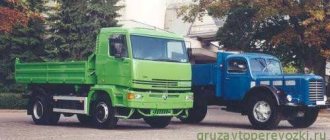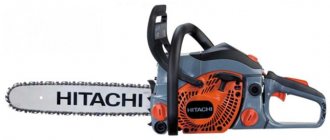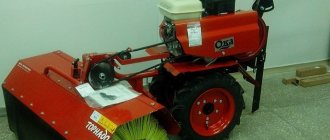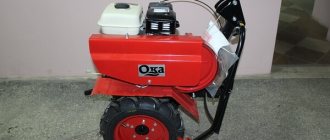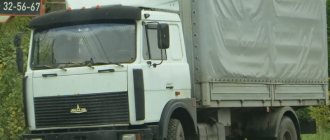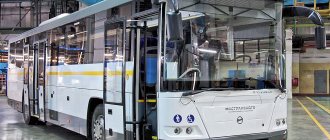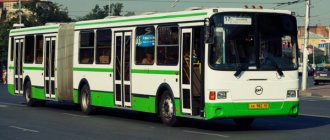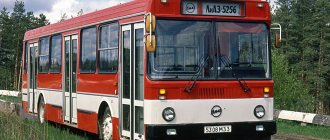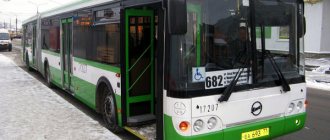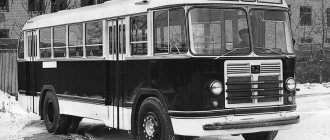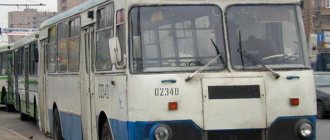The Skoda LiAZ car is a product of the so-called golden era of the American-European automobile industry. The combination of domestic and foreign production was a successful idea. Thanks to this, the world saw perhaps one of the most legendary trucks of the Soviet era.
It all started with the fact that the reconstruction of factories began in small towns of Czechoslovakia. Some of them merged, resulting in the formation of the Lyubertsy Automobile Plant, which became part of AZNP (the main plant of the Skoda brand).
After a year of operation, he gained complete independence in his work. But the products he produced were still released under a double name. This is how the Skoda Liaz brand appeared.
Technical characteristics of the Skoda liaz 100.42 truck
The two-axle new product weighed 19 tons, but as part of a road train its weight reached 38 tons. Thanks to this, the technical potential of the vehicle became much wider and made it possible to solve a lot of problems, especially in the field of long-distance cargo transportation.
Engines with increased power of 201 hp also appeared here, thanks to which the car could easily reach speeds of up to 98 km/h. For 100 liters the car required 37 liters of fuel, which even in current conditions is considered a moderate figure. The gearbox did not shine with uniqueness, and was a simple but reliable 5-speed mechanism.
A few months later, the modification was supplemented by tractors, which received the index 100.45, and after some time - flatbed trucks 100.05.
The rise and fall of the popularity of Skoda Liaz trucks
The Skoda Liaz is a legendary truck produced in the former country of Czechoslovakia. The history of the enterprise dates back to the middle of the last century, when the country's leadership decided to move production from the AVIA plant to Lyubertsy. It is curious that in the 70s the enterprise was the largest in the country for the production of trucks. The machines were highly reliable, easy to maintain, and had other advantages, which we will discuss later.
Skoda Liaz 110
The popular Skoda Liaz 110 model, again, received a number of visual changes. There is practically nothing left of the former exterior here. Another individual characteristic is the M630 engine (210 and 320 hp), the presence of an anti-lock braking system and a Maxi-class cab (in configuration 110.573).
For the first time, the cabin was able to tilt back. The rear air suspension was also a key factor in determining the popularity of the 110th model.
Like its predecessor, the Skoda Liaz 110 was actively exported to the USSR. The 100-110 tandem was a real guarantor of quality and reliability, which could often be found on long roads.
Reviews of Skoda LIAZ tractors
There are many Skoda LIAZ trucks left in the countries of the former Soviet Union. These are mainly mainline tractors of the 100 and 110 series, produced from the late 70s to the early 90s. Long-term operating experience has made it possible to identify both the advantages and disadvantages of Czech trucks.
More on the topic: JMC - Chinese trucks with a Japanese heart
Engine
Diesel engines installed on LIAZ 100-110 tractors are distinguished by reliability and durability, as well as low requirements for fuel quality. Unfortunately, their fuel system is not equipped with heating, so in winter it is recommended to use the appropriate grades of diesel fuel, or install a heating system yourself. Quite often starters fail, but since the design of the car provides for the installation of two starters at once, a malfunction of one of them will allow you to independently get to the repair site.
Chassis and transmission
Both units have a high service life even when used on domestic roads. The main disadvantage of the transmission is the lack of a centralized lubrication system, which, with proper care, does not affect the durability of the entire unit. Sometimes the saddle height of 1300 mm is too high for modern semi-trailers. In this case, the saddle is removed from the subframe and moved to the frame, having previously strengthened the installation site.
Cabin
There is enough space in the truck cabin; the driver's seat is mounted on air suspension with a hydraulic shock absorber; the steering column, along with steering column switches, is height adjustable. The interior heater is inconveniently located, the motor of which is susceptible to contamination, so in the summer it is recommended to close the air intake grilles with improvised means.
And finally, watch excellent video reviews of Skoda LIAZ trucks prepared by foreign journalists, as well as desktop wallpapers with trucks from the Soviet past:
Model 706
This device began to be supplied to the Soviet market in the 60s. The main configuration is a refrigerated road train capable of transporting food, medicine and cosmetic products over long distances. Unlike local models, the 706 is easier to operate and is also adapted to harsh operating conditions.
Modifications of the 706th model:
- 706RTS, type – dump truck;
- 706RTTN, tractor unit;
- Chassis 706RT, which was used for the production of buses, narrow special-purpose equipment, as well as flatbed trucks.
Each model was produced with a 160 hp engine. A little later, the devices began to be equipped with diesel engines and fuel injection. In terms of power, the power unit was divided into several types: 160, 180 and 210 hp.
The Skoda Liaz completed its journey in 1985. It was replaced by Liaz 100, which is described just above. Visual characteristics have made the device more noticeable, and the build quality allows the “old man” to work even now, albeit rarely.
The history of the Skoda Liaz brand ended in the late 90s. The collapse of the USSR and the inability to compete with more advanced analogues led the company to serious financial problems. The plant, which became bankrupt, curtailed production, but forever left its rally in the history of European and domestic mechanical engineering.
Škoda trucks. Part 2: 1950-2000
09 Oct 2013 |
Articles and reviews | Evgeny Zenkov | Discuss After the war, the leadership of Czechoslovakia decided to reduce the range of cars and trucks produced at various factories in the country. As a result, the Škoda automobile plant began building railway locomotives, and the production of trucks and buses was transferred to the Avia company in Letnany. By agreement with the design developer, the Škoda company, the same emblem remained on the linings of their radiators and the company name was retained.
The first post-war Škoda truck was named
Škoda 706 R , its production was established in Letnany from 1946 to 1951, and in June 1951 production was transferred to a plant in the village.
Rynovice, now part of the city of Liberec. In 1952, the new plant, together with branches in the cities of Mnikhovo Gradishte and Ganychov, became. Subsequently, this group of enterprises became the basis). Development of the Škoda 706 R began back in 1930, then the model was called Škoda 706. The post-war model differed from the 1930 model in a more spacious cabin, a more powerful diesel engine and had a greater load capacity - 7300 kg.
The diesel engine installed on the Škoda 706 R was a 6-cylinder with wet liners and pre-chamber mixture formation, and had several design features that greatly facilitated its repair and maintenance. The crankshaft was assembled at the factory from seven parts, and it rotated in a powerful crankcase on seven large-diameter roller bearings. During repair work, the pistons together with connecting rods could be removed from the block without dismantling the diesel engine from the car. The light alloy pistons contained four compression rings and one oil scraper ring.
The timing camshaft with pushers and rocker arms was driven from the crankshaft by a gear drive. The diesel engine was equipped with a compressor that served the car's pneumatic braking system, and was driven by a gear transmission from the crankshaft. Two filters with replaceable paper elements were installed in the oil line. Starting a cold diesel engine was facilitated by glow plugs located in each cylinder. A fuel injection pump with a centrifugal-type distributor supplied fuel through steel tubes to injectors that were easily dismantled for maintenance. The cooling system included a thermostat that controlled the flow of water in the water jacket.
The diesel engine capacity was 11,781 cm3 and had a power of 135 hp. at 1750 rpm. The maximum speed was 53.5 km/h. In real operating conditions, the truck's speed rarely exceeded 40 km/h. Average fuel consumption was about 30 liters per 100 km. Oil consumption was also quite high - 1 liter per 100 km!
Paired with a diesel engine, the Škoda 706 R was equipped with a 5-speed manual transmission with three pairs of constant mesh gears. The steering included a worm-roller type actuator, with low force on the steering wheel achieved by a large gear ratio and a huge diameter of the steering wheel. The designers installed an engine brake (a flap in the exhaust manifold), which many other European diesel trucks of that time could not boast of having.
The cabin of the Škoda 706R trucks was very wide - a driver and 3 passengers could easily fit in it. The cabin frame was made of wood and lined with steel sheets. In 1954, the cabin was replaced with an all-metal one, but by 1956 they had already decided to abandon it, because in 1956, a model with a “cab-over-engine” layout was presented. Trucks with such a cab, welded from steel elements, were assigned the index 706RT . Flatbed trucks were equipped with a wooden platform measuring 5000x2350 mm with three folding sides and a steel frame at the base of the floor.
In 1954, the trucks of the 706R family were modernized: a new radiator lining and fenders became more technologically advanced, and access to the engine for repair and maintenance was made easier (small areas appeared to the right and left of the hood, located behind the front bumper). Maximum diesel power increased to 145 hp. With. at 1800 rpm, which increased the maximum speed to 68 km/h. The modernized models with an onboard platform were distinguished by increased load capacity up to 7750 kg and consumed 32 liters of fuel per 100 km. Production of the 706R continued for another three years before it was discontinued in 1957.
The 706R was replaced by the Škoda-706MT . The model received an updated cabin, which differed from the previous one only in the design of the front part. The new cabin was installed on cars of the MT family and on those that continued to be produced RT. In 1973, a double cab was developed for vehicles operating on short routes - before that, all Škoda-706RT/MT were equipped with a “long” cab with a berth.
Simultaneously with the production of flatbed versions, the assembly of 706RS with metal platforms that unloaded on three sides began. The load capacity of the dump truck was limited to 6.5 tons with a curb weight of 7.26 tons. Their main area of application was urban and suburban construction. Another version of the truck was the Škoda-706ROK with a front cabin unified with a bus. Cars, as a rule, were offered as carriers of specialized equipment (as garbage trucks, etc.) or in the form of a van.
Škoda- 706RS
dump trucks played a significant role in the restoration of destroyed factories and cities in Czechoslovakia in the first post-war decade. Wheels with large tires (12.00-22) and huge ground clearance (250 mm) in the presence of a high-torque diesel engine provided the loaded vehicle with good cross-country ability, including on dirt roads. The presence of a heater, a relatively small force on the steering wheel and on the gearshift lever formed drivers' opinion of the Škoda-706RS (and in general of the entire line of 706R models) as a car that is convenient to operate at any time of the year. The design of the engine and transmission, proven over a decade, and the high quality of manufacturing of the cars guaranteed their excellent reliability and durability.
Since 1969, the Škoda-706MT4 and Škoda-706MT5 , equipped with the new M634 engine with a power of 210 hp. and a five-speed gearbox with a two-stage range.
In 1970, based on the 706MT series, a new family of LIAZ 100 trucks was created. In 1974, production of truck tractors of the new family began, and a year later - flatbed trucks. This meant the end of production of the corresponding models of the previous family. However, production of the Škoda-706MTS24, Škoda -706MTSP24 and Škoda -706MTSP27 dump trucks continued until 1987.
Cars of the Škoda-706RT and -706MT families were produced in Bulgaria under the LIAZ-Madara brand from 1970 to 1981. Since 1975, drive axles for these cars were produced in Bulgaria and supplied to Czechoslovakia.
In the USSR, Škoda-706RT cars appeared in the early 1960s. the Škoda-706RTTN truck tractors with refrigerated semi-trailers were transferred to the Soviet Union for testing.
Subsequently, refrigerators became the main type of semi-trailers with which Czech tractors worked in the USSR. The Škoda-706RTTN received high praise from the test results, but there were no immediate deliveries. Only in 1964 was a decision finally made to purchase Czech tractors, and Skodas and Pragues with Orličan refrigerated semi-trailers began to arrive in the USSR.
In addition to truck tractors, the USSR received Škoda-706RT flatbeds and Škoda-706RTS dump trucks (as well as their analogs of the Škoda-706MT family).
Škoda-706RT trucks have proven themselves to be the best. Based on the 706RT model, trucks were designed for a wide variety of needs and industries: fire trucks, flatbed trucks, tank trucks, truck cranes and other modifications.
They were respected for their reliability and durability, as well as for the comfort of the driver’s workplace, unattainable for domestic manufacturers.
Many Škoda-706RTs worked until the mid-nineties, and some examples are still found on the roads today.
In 1973, the production of trucks under the Skoda brand ceased and the production of LIAZ trucks began (although the LIAZ plant became independent back in 1953, it produced trucks with the Skoda logo for another 20 years). The debut of the LIAZ brand took place at the World Fair in Brno in 1973.
In September 1995, the LIAZ plant was included in the Škoda heavy engineering concern. Having bought shares of LIAZ factories and closing a number of unprofitable enterprises, he formed a new joint-stock company - “Skoda-LIAZ as”, which only had 4 enterprises in the cities of Jablonec na Nisa, Liberec, Mnikhovo Hradište and Melnik. At first, the program included all previously produced cars, which received a new trademark “Škoda-LIAZ” and changed model indexing.
These include the “S”, “FZ”, “110/150/250”, “300” and “MZOO” series with a gross weight from 9 to 40 tons with wheel arrangements from 4x2 to 8x4 and diesel engines of our own production or Austrian Steyr engines with a power of 180-410 hp.
And in 1996, Škoda-LIAZ launched a new truck on the market - the Xena 19.47TBV long-haul tractor (for road trains with a gross weight of up to 44 tons, which headed the new 400 series.
It is equipped with a 6-cylinder Detroit Diesel turbocharged engine (volume 12742 cm3, power 437 or 477 hp), 16-speed Eaton gearbox, imported axles, front disc brakes, ABS, rear air suspension with electronic control, new spacious cabin made of multilayer fiberglass on an aluminum frame. In 2000, a new Fox series with a gross weight of 19 tons and engines with a power of 290-330 hp was added. In 2003, production of Xena and Fox trucks ceased.
In 1999, Skoda, with the help of Truck International AS, acquired the newly organized Jablonec Skoda Motory, which became a subsidiary. On February 28, 2002, Skoda Motory became JAMOT (Jablonecky Motory) and declared bankruptcy on June 17. On July 1, 2003, JAMOT became part of the TEDOM concern. In the same year, TEDOM began bankruptcy proceedings for LIAZ, and in 2002, the engine plant in the city of Jablonec, the main supplier of power units for the conveyors of the former giant SKODA-LIAZ, was also declared insolvent. In just 50 years of its existence, Skoda-LIAZ has produced about 350 thousand trucks and bus chassis.
09 Oct 2013 | Articles and reviews | Evgeny Zenkov | Discuss
Share with friends
How it all began?
The emergence of the enterprise was preceded by a grandiose reconstruction of small factories in several localities in Czechoslovakia. As a result of the merger of small factories, a large manufacturing plant was formed, called the Lyubertsy Automobile Plants. It is noteworthy that the resulting enterprise was part of AZNP, the main Skoda plant. A year after the merger, LIAZ gained autonomy, but at the same time, the trucks coming off the assembly line were called the double name Skoda Liaz. This continued until 1984.
History of the Liaz brand
The history of LIAZ begins in the early 50s, when Skoda trucks, which were produced at the AVIA Prague plant, were transferred to the city of Liberec in northern Czechoslovakia. For this purpose, some small mechanical enterprises located in the small towns of Rynovice, Liberec, Mnikhovo, Hradiště, and Svijany Loukov were reconstructed.
They first became part of the parent People's Enterprise (AZNP) in Mladá Boleslav and formed the Liberecke Automobilove Zavody, abbreviated LIA3 (LIAZ). On January 2, 1952, production of the Skoda-706R cabover trucks began in Rynovitsa, and by January 1, 1953, when the LIAZ enterprise gained independence, over 950 vehicles were manufactured. The composition and profile of the factories that were part of LIAZ (up to 12 enterprises) changed repeatedly.
Over time, the main plant became the one in the town of Jablonec na Nisa, which absorbed Rynovice. The assembly of the new Skoda-706KT and 706MT trucks began in the city of Mnichovo Hradište, and the engines for them were first produced in Hynikhovo, and then in Jablonec na Nisa. These simple, durable and unpretentious vehicles became the basis of the new “100” series of heavy cab-over trucks, which sought to conquer the markets of industrialized countries. Developed at LIAZ enterprises, the cars received a new trademark “LIAZ”, which replaced the well-known name “Skoda” for 20 years.
The first series of “LIAZ 100” consisted of 2-axle trucks with a total weight of 16-19 tons and truck tractors for road trains with a total weight of 36-38 tons. In 1974, production of the “LIAZ 100.45” truck tractor began, and a year later - 8 ,5-ton trucks “100.05”. From the “706MT” range, only dump trucks “MTS24” (4×2), “MTSP24” and “MTSP27” (4×4) remained on the conveyor. The second generation of LIAZ cars began to take shape in the early 80s. In 1984, with the creation of a tilting version of the first cab, the “110” series appeared, which received rear air suspension, as well as the “122” (6×2) family of 3-axle vehicles, which consisted of a “122.03” flatbed truck with a total weight of 26 tons. and the “122.48” truck tractor for 42-ton road trains.
85 built several “100.55D” (4x4) trucks for the Paris-Dakar marathon, which gave birth to the all-wheel drive “111” series. In the 1987 rally, the LIAZ 111.154 version achieved the highest result for the plant, taking third place. Since 1987, production of dump trucks “150” (4×2) and “151” (4×4) began, which finally replaced the “706MT” series, as well as the second basic family “200”, which differed only in enhanced cabin sound insulation and brakes with ABS. All cars could be ordered with one of five options for the in-line 6-cylinder diesel engine “M630” (11946 cm 3) with direct injection, several types of gearboxes and four wheelbase sizes.
In the 80s the engine had versions “M634”, “M636”, “M637”, “M638” and “M640” with power from 210 to 320 hp, including options with turbocharging and intercooling. Despite this, the LIAZ plant was never able to create cars that fully meet the stringent requirements of Western European countries. By the end of the 80s. The demand for LIAZ cars began to decline rapidly. On economic and technical problems in the early 90s. added to the collapse of Czechoslovakia. In the new economic conditions, the enterprise not only lost its main foreign markets, but was also unable to withstand competition in the domestic market.
At this time, the LIAZ plant made efforts to modernize its program. So in 1990-92. truck tractors “110.573” with an increased volume cab “Maxi” (Maxg) and ABS appeared, as well as the model “230.575”, for the first time equipped with an in-line 6-cylinder 4-stroke engine “Detroit Diesel” of the “60” series (12742 cm 3, 365-400 hp). By the mid-90s. An updated program consisting of five basic families was formed. The first series “S” and “FZ” included delivery trucks with a total weight of 9-17 tons with a 6-cylinder Steyr diesel engine with a capacity of 180 “horses”.
The cars differed in whether they had cabins of their own production or those assembled under an Austrian license. The “300” series consisted of the more than once modernized “100” family with wheel arrangements from 4x2 to 8x4 with a total weight of 18-40 tons. Their options were the “M300” truck tractors with basic turbocharged engines (models “M636E/S”, “M640F/S/T” and “M640FE/SE/TE”, 230-408 hp), as well as “ Detroit Diesel” (355-450 hp). The fifth family consisted of trucks of the “110”, “150” and “250” series with the previous “M636”, “M637” and “M640” engines (208-305 hp) in the so-called “Euro-0” version for countries where strict environmental regulations are not yet in place.
In 1992, the three-year privatization of LIAZ enterprises began. In 1995, the heavy engineering concern Skoda became the main owner of the shares, and the new joint-stock company became known as Skoda-LIAZ. Since then, all products have received a new trademark “Skoda-LIAZ” and other indexing.
©. Photos taken from publicly available sources.
